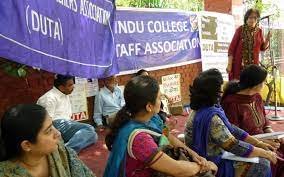The issue of faculty shortages in India’s higher education sector has been a persistent challenge since the 1980s, and sadly, it seems to have become a permanent problem today. This paucity of a sufficient number of faculty members not only undermines the growth of the country’s knowledge sector but also hinders its aspiration to be recognized as a “vishwa guru,” a global leader in education and research. For colleges and universities to thrive and fulfill their roles as centers of knowledge creation and dissemination, it is imperative to address this pressing issue.
The shortage of faculty members in India’s higher education institutions has far-reaching implications. One of the most significant consequences is the strain it places on the student-teacher ratio. With a limited number of faculty available, the burden on existing professors and lecturers becomes overwhelming. This adversely affects the quality of education imparted, as educators are stretched thin and unable to provide individual attention and mentorship to students. As a result, the overall learning experience suffers, and students may not acquire the necessary skills and knowledge required to excel in their respective fields.
Moreover, the shortage of faculty also impacts the research output of institutions. Research and innovation are critical drivers of societal progress, economic growth, and technological advancement. However, without an adequate number of teachers and researchers, institutions struggle to conduct cutting-edge research and produce groundbreaking discoveries. This not only hampers the development of new knowledge but also weakens India’s position in the global research landscape.
Several factors contribute to the perpetuation of faculty shortages in India’s higher education sector. One primary reason is the lack of attractive career opportunities and incentives for individuals to pursue teaching and research as a profession. Many talented individuals prefer alternative career paths that offer better financial rewards and stability. Additionally, the limited availability of specialized training programs and professional development opportunities for aspiring academics further exacerbates the problem. Without proper support and guidance, individuals may be discouraged from pursuing a career in academia.
Another factor is the significant emphasis on quantity over quality in the recruitment process. Often, institutions prioritize filling vacant positions quickly, leading to compromises in the selection criteria. This results in the recruitment of underqualified or inexperienced individuals, which ultimately undermines the overall quality of education and research.
To address these challenges and overcome the faculty shortage crisis, a multi-faceted approach is required. Firstly, the government must prioritize and invest in higher education, allocating sufficient funds to improve infrastructure, create more positions, and provide competitive salaries and benefits for faculty members. Additionally, efforts should be made to attract and retain talented individuals by offering attractive career progression opportunities, research grants, and sabbatical leaves to pursue advanced studies and collaborations.
Moreover, it is crucial to focus on enhancing the training and development programs for aspiring faculty members. Specialized training initiatives should be established to equip individuals with the necessary pedagogical and research skills. Mentorship programs can also play a vital role in nurturing young academics and fostering a supportive environment for their growth.
Furthermore, reforms in the recruitment and selection process are essential to ensure that merit is prioritized. Stringent evaluation mechanisms and transparent procedures should be put in place to attract the best talent and prevent compromises in the quality of appointments.
Lastly, fostering collaborations between academia and industry can help bridge the gap between theoretical knowledge and practical applications. By encouraging faculty members to engage in industry projects and consultancies, institutions can enhance the relevance and impact of their research, attracting more individuals to the field of academia.
The persistent faculty shortages in India’s higher education sector pose significant challenges to the growth and development of the country’s knowledge sector. Addressing this issue requires concerted efforts from the government, educational institutions, and stakeholders. By investing in infrastructure, improving recruitment processes, providing adequate support and incentives, and fostering collaborations, India can overcome these shortages and strengthen its position as a global leader in education and research.


